Last week, my daughter Kaitlin shared an experience she had while walking her dog. She witnessed a man abusing his beagle. The man repeatedly yanked the beagle’s leg trying to force him to sit down – no commands; no cues – just force.
Kaitlin shared this story on Facebook as a dilemma. For you see she didn’t say anything to the dog abuser – rather, she stayed silent. She was obviously bothered enough to post her dilemma on Facebook and ask her tribe of friends/family what THEY thought she should have done.
The replies were quite interesting and some, humorous. From “should have video taped and sent to Humane Society, “follow him home and steal the dog,” to validation that dog abuse is wrong and more needs to be done about it. But, in the end, every reply indicated that she should have said something to stop the abuse.
Here’s what you don’t know about my daughter. Although Kaitlin is a Phys-Ed and Health teacher, her ultimate goal is to open and run a no-kill dog shelter. WOW.
BIG QUESTION
If Kaitlin, whose purpose in life is to nurture and protect dogs, can become a passive bystander when witnessing the abuse of those dogs, what does that mean for the rest of us?
No wonder bullying is still rampant even though there are good people out there trying to stop it!
REALITY
We live in a world in which good people remain passive in the face of bullying and injustice. A study of 1700 nurses shows that 90% won’t speak up in the face of bad practice (behavior), even in life and death situations.
What is true in hospitals is true in schools, neighborhoods, shopping centers, and even parks where people walk their pets.
If 90% of individuals won’t speak up in the face of bullying, bad behavior, and injustice, there must be compelling reasons.
Reasons
· Culture of individualism (none of my business, not my responsibility)
· Fear (how will this person react towards me?)
· Discomfort (emotion, uncertainty, etc.)
· Not knowing what to do (caught by surprise, lack of knowledge and practice)
The result is weak muscles of moral courage. In the face of bad behavior, we are passive. Then, because we are good people, we berate ourselves (like my daughter did). And because others see our impassivity, the culture of turning a blind eye is reinforced.
GOOD NEWS
The prescription for passivity is conscious choice, supported by knowledge and practice. The movement to a hero culture begins with recognizing you have power to take action in the face of injustice. You build your moral courage muscles in everyday choices. Small exercises, repeated over time, build muscles that prepare us for big challenges.
· Understand you are part of a community. Choose to accept your responsibility.
· Acknowledge your fear and do it anyway. Become comfortable with being uncomfortable.
· Prepare. Make the decision ahead of time that you will speak up if you ever witness ________.
| Kaitlin and her dog Saphira |
While reading all of the responses to Kaitlin’s dilemma, I could see her moral courage muscles strengthening. Her last comment, “Now I’m kicking myself for not saying or doing anything!! I hope I never see something like this again, but if I do I’ll be ready! Thanks friends!” (I’m a proud mom)
Understand that moral courage isn’t something you’re born with; it’s something that develops over time. If you’ve been passive about injustice in the past, even with something you’re passionate about, don’t beat yourself up. Just recognize that while you chose to be passive before – you won’t be passive the next time.
For more great tips on how to stop bullying, check out my bully tools by clicking here.
Be kind to each other. Take care and stay connected.













